Envisioning the Skies: A Short History of Astronomical Films
"Brilliant Noise" by Semiconductor
Los Angeles Filmforum and Mt. Wilson Observatory presents
Envisioning the Skies: A Short History of Astronomical Films
Saturday August 23, 2025, 3:00pm
At Mt. Wilson Observatory, 100 Mt Wilson Circle Road, Mt Wilson, CA 91023
NOTE THE CHANGE IN DAY, TIME, AND LOCATION!
Access to Mount Wilson is via the Angeles Crest Highway (CA Hwy 2) from the 210 Freeway at La Canada Flintridge. Directions given by apps on your phone can be incorrect. We recommend downloading and printing our PDF map with directions here: https://www.mtwilson.edu/1map/ DO NOT USE Apple Maps for directions; it sends you to a fire road that you can’t actually use. There are two parking lots up on the hill, and you can walk to the auditorium, or there will be a shuttle cart as well for those who need it. The Auditorium is next to the Astronomical Museum, “B” on the campus map.
** Allow at least 45 minutes from La Canada-Flintridge to the Mt. Wilson campus.**
**Be aware you will need a U.S. Forest Service Adventure Pass to park at the Observatory, as it is located on U.S. Forest Service land. The $5 day pass or the $30 dollar annual pass may be purchased at the Cosmic Cafe on weekends, or at many locations around Los Angeles before you head up. The U.S. Forest Service website has more information and purchase locations. https://www.mtwilson.edu/1map/
https://www.mtwilson.edu/events/movie082325/
Tickets: $20 Adults; Children 12 and under, $15
For the Matinees on the Mountain series, see https://www.mtwilson.edu/movies/
This showcase presents a series of films related to astronomy that examine how scientific knowledge depends on traces left directly by natural phenomena themselves - so-called indexical images. Before being ideas, scientific theories are themselves constituted by image making. With computer-generated imagery, it has become increasingly difficult to recognize the indexicality of the film image, mainly because of simulation. In the case of scientific films, this issue is even more delicate, as the image requires a direct recognition of reality, under penalty of not constituting scientific evidence. With increasingly aestheticized images, scientific images in turn are captured from distant spaces, through sophisticated hybrid technologies, very different from the optical array images of telescopes. This screening intends to present an overview of films considered scientific, with educational intentions on astronomy since before the invention of cinema, so that the most diverse film techniques used by filmmakers and scientists in different eras can be appreciated.
The selection begins with Passage of Venus (1874), when astronomer Jules Janssen first used sequential photography to record Venus crossing the sun's surface. Declaring the photographs were “drawn by the sun, himself”, Janssen persuaded the astronomical community for replacing hand-made observational drawings with this new scientific instrument. Since then, the relationship between science and image representation has been marked by an ongoing tension over the role of instruments - from cameras to computers - as tools of precision measurement and observation. In the digital age, the concepts of "imaging," animation, and simulation introduce new potentials and complexities. Contemporary instruments - radio telescopes and infrared detectors - capture data beyond visible light, demanding new visualization methods and interpretation. This transformation invites us to rethink the nature of scientific evidence and the role of imaging in the construction of astronomical knowledge, at a time when the boundary between recording and simulation becomes increasingly blurred.
In this screening, some of the films show how the images directly captured from nature are used in cinematic fashion, and also for educational purposes. Bernard Lyot captured unprecedented images of the sun using the coronagraph he developed, creating a film from this footage. Flammes du Soleil, created later to honor Lyot, presents his solar footage as a choreographed spectacle, anticipating today's computer-simulated astronomical images stored in observatory and laboratory databases. This approach to astronomical visualization continues with Cosmic Cycles: A Space Symphony from NASA's Goddard Space Flight Center, which merges diverse astronomical images into a journey through space, exploring the universe as a musical symphony. Planetary Fantasia is scored by the National Philharmonic with the composition by Henry Dehlinger.
Equally remarkable but educational in purpose, the Cosmos TV series (1980-81), hosted by Carl Sagan, cinematically featured Voyager spacecraft imagery alongside the first computer images. Jim Blinn manipulated Voyager's data and photographs to create what became known as a "computer simulation," showcased in the Cosmos episode The Persistence of Memory. Blinn's groundbreaking work featured a computer-rendered Voyager spacecraft orbiting Jupiter, creating a fly-by simulation that pioneered new computer modeling techniques.
The next two films demonstrate speculative image techniques that foresaw future discoveries and instruments. Pavel Klushantsev's "Mars", a Soviet science film, anticipated later achievements: the exploration of Mars by robots, crewed spaceflight, and humanity's first steps on Martian soil, along with a canine companion!
Powers of Ten, directed by Ray and Charles Eames, used cleverly layered photographs to simulate continuous zooming in and out from human scale. The film shifts from traditional central perspective to a logic of scalability - moving between telescopic and microscopic views in powers of 10, foreshadowing today's Google Earth visualization approach.The film anticipates computerized ways of seeing images as a scopic field - understanding the world not through opposites or central perspective, but through scaling between global and local, micro and macro dimensions.
The screening concludes with Tom Bridgman's exquisite 2012 Venus transit visualizations for NASA/Goddard's Scientific Visualization Studio. These pieces stand in counterpoint to Janssen's documentation of the 1874-1888 transit cycle, creating a dialogue between historical and contemporary imaging tools. The next Venus transit awaits in 2117.
Curated by Jane de Almeida, Adam Hyman, Jheanelle Brown.
Jane de Almeida is an interdisciplinary researcher working at the intersection of arts, film, and new media, with a focus on subjectivity and perception. Her international academic career includes positions as Visiting Scholar in the Department of Philosophy at Boston College, Visiting Fellow in the Department of Architecture and History of Art at Harvard University, and guest researcher at MediaLabMadrid. She further expanded her research as a Visiting Professor in the Visual Arts Department at the University of California, San Diego, where she also served as artist-in-residence at the Arthur C. Clarke Center for Human Imagination, developing the project Loga: Mars Projections. Currently, de Almeida is a professor in the Arts Department at the Catholic University of São Paulo, Brazil, while coordinating the Laboratory of Scientific Image (LIC) at the State University of Campinas (UNICAMP). Her curatorial work spans exhibitions including "Harun Farocki: Programming the Visible" at Paço das Artes, "Off the Radar" at the Visual Arts Gallery at UC San Diego, "Ulla, Ulla, Martians, Intergalactics and Aliens" at Casanova, “Black Zero: Aldo Tambellini” at Casanova and Museum of Modern Art (MAM) of São Paulo, and "Quantum Art" at FILE. She also curated the exhibition "Ordering and Vertigo," which was showcased at the Cultural Center Bank of Brazil (CCBB) across multiple locations including Rio de Janeiro, Brasília, and São Paulo.
Experimentations: Imag(in)ing Knowledge in Film was Filmforum’s expansive film series and upcoming publication that investigates the ways that experimental and scientific films produce and question the visualization of the world. Combining artist films utilizing scientific imagery, science and natural history films, and films of indigenous and traditional knowledge, the series examines how science, nature, and technology films shape our understanding of humans, nature, gender, knowledge, and progress. The multi-venue public screening series presents analog and digital time-based media incorporating diverse scientific and experimental film traditions from across the globe.
Major support for Experimentations: Imag(in)ing Knowledge in Film is provided by the Getty Foundation and The Andy Warhol Foundation for the Visual Arts. Additional Support from the Los Angeles County Board of Supervisors through the Los Angeles County Department of Arts & Culture, and the Department of Cultural Affairs, City of Los Angeles.
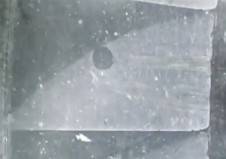
Passage artificiel de Vénus sur le Soleil, 1874
Passage artificiel de Vénus sur le Soleil
Pierre Jules César Janssen, France/Japan, 1874, digital, b/w, silent, 0:30
The earliest “film” and “astronomical film” if you wish to define it as a film: a series of photos placed in sequence of the transit of Venus across the Sun.
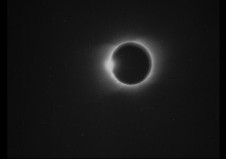
Solar Eclipse, 1900
Solar Eclipse
By Nevil Maskelyne
1900, digital version, b&w, silent, 1 min.
‘Nevil Maskelyne, celebrated magician, proprietor of the Egyptian Hall and astronomy
enthusiast, filmed this solar eclipse in North Carolina on May 28, 1900. Recently discovered in the collection of the Royal Astronomical Society, the film is believed to be the first surviving astronomical film in the world. It is a fragment showing the corona around totality and the 'diamond ring' effect.’ – British Film Institute

Tides and the Moon, 1920
Tides and the Moon
By F. Lyle Goldman/Bray Pictures
USA, 1920, 16mm transferred to digital, b&w, silent, 5:33
Animated diagrams, coupled with live-action footage, illustrate how the moon's gravity creates ocean tides on Earth, and how the combined gravitational forces of the moon and the sun result in spring and neap tides. Films such as If We Lived On The Moon and Tides and the Moon were made with the intention to propagate ideas about astrophysics in a didactic way, demonstrating the difficulties of interplanetary travel and, and some of them, denouncing films and fiction novels as chimeras.
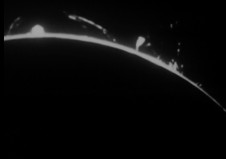
Flammes du soleil, 1935
Flammes du soleil
By Bernard Lyot,
France, 1935 with added commentary by Paul Couderc, 1957, b&w, sound, 11:00. From CNRS Images, France.
Film made in memory of Bernard Lyot, astronomer, member of the Academy of Sciences and inventor of the coronagraph.
Paul Couderc, astronomer at the Paris Observatory, comments on the images that Bernard Lyot made in 1935. Lyot invented the coronagraph which allowed filming of the sun, the solar corona, the protuberances and the columns of gas on the surface of the sun.
Mars (Russian: Марс)
By Pavel Klushantsev
USSR, 1968, digital transfer, color, sound, 10 min excerpt from 48 min.
Like the previous film Luna produced by Klushantsev, the film Mars was created at the intersection of educational science films and science-fiction. It consists of seven pieces, which tell (based on scientific understanding of the 1960s) of the physical conditions on planet Mars, the possibility of life on Mars and what forms it might take, of Martian canals and "seas" of the Red Planet. - Wikipedia.
In addition, the film includes the director's fantasy hypothetical forms of life on Mars, and of the exploration and colonization of Mars in the near future.
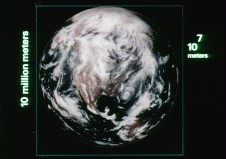
Powers of Ten
Powers of Ten
By Charles and Ray Eames
USA, 1977, digital, color, sound, 9:00
Powers of Ten and the Relative Size of Things in the Universe (1977) is a film created by the Eames Office investigating the idea of an exponential series. The film illustrates scale and the significance of adding a zero to a number. It begins with a scene on Earth: a man and woman picnicking in a park bordering Lake Michigan in Chicago. The journey unfolds as the camera steadily moves away from the couple, reaching the edge of the known universe. The camera reverses its movement back to Earth’s park scene, going further to reach the atomic level of the hand of the napping man on the picnic blanket. Original music score by Elmer Bernstein.
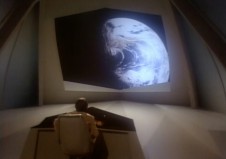
Cosmos: A Personal Voyage
Cosmos: A Personal Voyage
Carl Sagan/Ann Druryan, USA, 1980, digital, color, sound, 10 min.
Excerpt from Episode 11 “Persistence of Memory”
Brilliant Noise, 2006
Brilliant Noise
By Semiconductor
2006, digital, b&w, sound, 5:47
Brilliant Noise takes us into the data vaults of solar astronomy. After sifting through hundreds of thousands of computer files made accessible via open access archives, Semiconductor have brought together some of the sun's finest unseen moments. These images have been kept in their most raw form, revealing the energetic particles and solar wind as a rain of white noise. This black and white grainy quality is routinely cleaned up by NASA, usually hiding the processes and mechanics in action behind the capturing procedure. Most of the imagery has been collected by satellites orbiting the Earth as single frames, or files of information, that are then reorganised into spectral sequences. The soundtrack brings to light the hidden forces at play upon the solar surface, by directly translating the intensity of the brightness into audio manipulation.
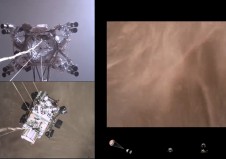
Cosmic Cycles 5: Planetary Fantasia, 2023
Cosmic Cycles 5: Planetary Fantasia
By James Tralie, Wade Sisler, and Henry Dehlinger
USA, 2023, color, sound, 12:36,
Courtesy NASA's Goddard Space Flight Center
Producers: James Tralie (ADNET Systems, Inc.), Wade Sisler (NASA/GSFC)
Editor: James Tralie
Music composer: Henry Dehlinger (National Philharmonic)
Music credit: “Planetary Fantasia" from Cosmic Cycles: A Space Symphony by Henry Dehlinger. Courtesy of the composer.
Earth’s siblings, the other planets were created at the birth of the solar system. They give us a glimpse of the variety possible in the universe and how rare Earth is. As we explore these other worlds, we fuel our adventurous spirit and discover new wonders at every turn: riverbeds on Mars, volcanoes on Jupiter’s moon Io, auroras on Saturn, and sulfuric-acid clouds on Venus.
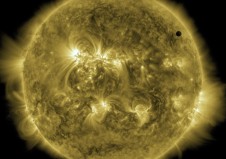
Venus Transit 2012 Composited Visuals
Venus Transit 2012 Composited Visuals
By Tom Bridgman
USA, 2012, digital, color, silent, 3 min.
Visualizations by: Tom Bridgman / NASA
(2nd, 3rd, and 5th views)
A high-cadence view of Venus Transit in HMI. 1:06
A high-cadence view of Venus Transit in AIA at 304 angstroms 37 seconds
Composited Full Disk frames, constructed by compositing the AIA 171 high-cadence inset with the low cadence full-resolution disk. 38 seconds
